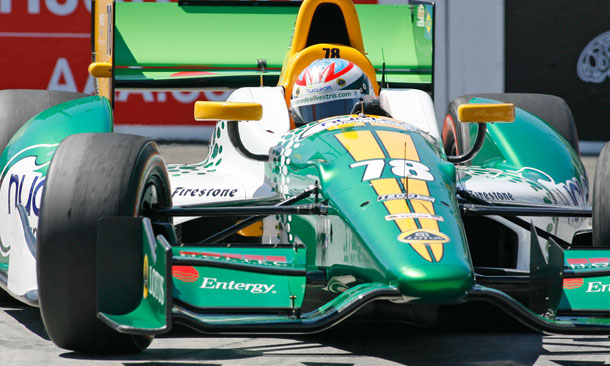De Silvestro's car running the first of engine updates
JUL 06, 2012
TORONTO – Simona de Silvestro has taken the glass-is-half-full approach to the season in regards to the first-year Lotus engine platform at HVM Racing. Really, what else can the third-year IZOD IndyCar Series driver do?
The 2.2-liter, twin-turbocharged V6 engine designed and produced by Engine Developments Ltd. in England for Lotus has been down on power through the first half of the season, which has decidedly impacted the results of de Silvestro’s No. 78 Nuclear Clean Air Energy car.
“On one side, I’m lucky to be part of an engine development. Not many drivers get to do that, so it’s a good learning process and I’ve learned a lot this year,” de Silvestro said. “I’m going to take pretty much every possibility out of it to learn from it, and that is going to make me better in the future.
“As a race car driver, you want to be winning races and running up front, so every race weekend you try to do the best you can. That’s what racing is all about. You can’t always have the best equipment out there, and you just have to shine with what you have right now.”
For the Honda Indy Toronto, the team received its first engine update, pursuant to INDYCAR engine technical regulations. At mid-season and again at the end of the year, manufacturers whose engines are statistically more than 2½ percent deficient in power may, at the discretion of INDYCAR, make improvements to components to be homologated. Alterations are intended to put the engine within the 2½ percent window, and they will be introduced on only new engines being sent to the track.
Subsequent modifications are scheduled to be incorporated for the Indy Grand Prix of Sonoma (Aug. 26-28) and the Grand Prix of Baltimore (Sept. 2-4).
The No. 78 car will receive a 10-grid spot penalty for the 85-lap Honda Indy Toronto on the 1.75-mile, 11-turn Exhibition Place circuit for the team changing out the engine before it reached its mileage limit defined in Rule 15.5.1.
Because the team fitted its sixth engine of the season for the Toronto race (the engine service agreement is five), in violation of Rule 15.1.4, it will receive a 10-grid spot penalty at the Edmonton Indy in two weeks.
"It’s kind of hard to say what everybody else did, but I think we improved the car," said de Silvestro, who was 20th quick overall through two practice sessions (.8685 of a second behind front-runner Dario Franchitti). "We made some big progress so I’m pretty happy about that. We’ll have to see in qualifying. That’s when we’ll know where we’re at.
“Lotus has worked really hard the last month to get the updates (and) we just need to keep focusing on what we are doing. It’s been frustrating so far this season because we had a strong race car at Detroit and again at Iowa, but with less power it was so hard for us to pass. We seem to be able to keep a good pace, but when it’s time to pass we don’t have the speed to do it.”
The updated engine wasn’t quite ready to install in the No. 78 car for a July 2 test at Mid-Ohio Sports Car Course as planned, so de Silvestro worked on a new shifting strategy.
“We will bring in as much performance as we can, with reduced fuel consumption which is as important, and which means that we will accept the 10-spot grid penalty for any upgrade," Lotus director of motorsports Claudio Berro said.
The No. 98 Team Barracuda-BHA car driven by Alex Tagliani also will incur a 10-grid spot penalty at Toronto as the team has chosen to install its fourth fresh engine instead of refitting its Indianapolis 500 practice/qualifying engine after meeting the mileage limit of its Indianapolis 500 race engine (Rule 15.5.4.b violation).
















